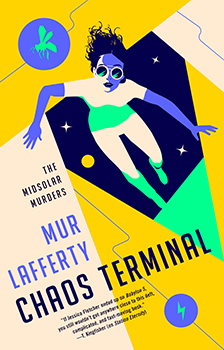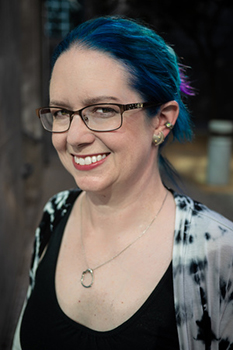

Features Mur Lafferty
Blending Genres with a Bang!
The Big Thrill Interviews Mur Lafferty
 Mallory Viridian is back! After surviving a serial killer in Station Eternity that resulted in the sentient space station Eternity almost tearing itself apart, Mallory is now faced with confronting her past while solving the murder of a scheming, opportunistic gossip blogger who seemed to have more enemies than friends.
Mallory Viridian is back! After surviving a serial killer in Station Eternity that resulted in the sentient space station Eternity almost tearing itself apart, Mallory is now faced with confronting her past while solving the murder of a scheming, opportunistic gossip blogger who seemed to have more enemies than friends.
In CHAOS TERMINAL, Mur Lafferty’s second novel in the Midsolar Murders series, we meet people from Mallory’s past. Her childhood best friend Amy, Amy’s twin brother and Mallory’s super-crush Parker, and Don Draughn, the former investigator who always thought it odd Mallory was at the site of so many different murders.
All the old emotions wake up with a bang, leaving Mallory reeling and out of sorts—both mentally and physically. As Mallory tries to make peace with the ghosts of her past, a new threat emerges. Their home, Eternity, isn’t responding to usual requests, and the Sundry hivemind that helps control the station to which Mallory is connected begins acting erratically.
Disaster looms, and it seems like the ghosts of the past might win this time after all.
The Big Thrill was pleased to sit down with Mur Lafferty to discuss blending genres, how we fight our own ghosts, and why Jessica Fletcher wasn’t ever suspected of being a serial killer.
Part of writing sci-fi/fantasy books is world-building, but typical mystery novels start with a Bang! and race down a path of clues. How were you able to balance writing a thorough introduction to Mallory’s world with still crafting the falling domino action of the mystery?
I know the first thing to say would be rewrites. <laughs> This wasn’t a conscious decision, but I realized as I’m writing these books I have a B plot, that is usually the fate of the station and Mallory and her friends, and an A plot that’s the murder mystery.
I have studied a lot of Agatha Christie and Caroline Graham, who wrote the Midsomer Murders books. Both of them actually wait a little bit of time before presenting the body. I know that a lot of thrillers and mysteries these days tend to throw [the murder] in a lot faster, but because these [authors] are mostly what I read and learned from, I throw the body in a little later.
The Sundry, a small wasp-like species that are either blue or green, share a mental connection with Mallory after stinging her as a small child. They seem to be a background element to the story until halfway through the book when we realize they play a much bigger part to daily life on Eternity. I can’t help but feel parallels to our own ecosystem, where we don’t worry about our insect species until we need them. Was this intentional?
Probably not. <laughs> I’m a very literal writer, and so if subtle things come across, it’s definitely subconscious instead of me choosing to do so. Without giving away too much, I’m friends with Ursula Vernon, who is known for winning lots of awards and having really weird animal facts. We were talking about wasps…and we had this long conversation, which gave me about 80% of the ideas for this book. I was thinking about all the weird wasp stuff she told me, and I was like, “I can turn that into something alien.”
CHAOS TERMINAL features an interesting love/friendship triangle between Mallory, her childhood best friend Amy, and Amy’s twin brother Parker. Mallory left them all behind on Earth and is stunned when they appear on the space station Eternity. Can you tell us a little bit about the dynamics at play here?
The twins were very close as children, but when they met Mallory, Amy wanted to be her best friend, and Parker fell in love with her. Amy didn’t want them together because she didn’t want her best friend going with her brother, because either they leave her out or they break up and [their friendship] would be awkward.
The teenage years are filled with strife for most of us and all the bubbling hormones and hurt feelings and everything, so trying to have people [from your past] connect on a level that is friendship or attraction or something even deeper can be [emotionally] difficult. Mallory and Parker tried to abide by Amy’s rules, but some things happened that have to do with the plot of the book, which is one reason why they left Mallory’s mind almost completely.
I think a lot of us can identify with the rule that you don’t date your friend’s brother because we’re afraid of the dynamics of our friendship changing. Is that something Mallory grew out of? Or is she plunged right back into high school?
Well, unfortunately, Mallory’s view of friendship changed as she grew older, and more murders started happening around her. People didn’t want to be around her because someone would get murdered. She [brings] strife into their family. So, she started backing off and having a completely different view of friendships as almost unattainable.
The twins aren’t the only people from Mallory’s past who’ve come to Eternity. Mallory also has to face Don Draughn, the investigator who used to hound Mallory because she seemed to be at the center of an astonishing number of murders. What does his presence mean for her?
Detective Draughn is a fun character to write because when you look at stories about amateur sleuths, the cops don’t like them, but the cops don’t like them because they solve the murders, not because they are [constantly there] when the murders are happening.
This guy has determined something is up with Mallory because [murder] keeps happening around her, and he became obsessed with her. He stopped her from being able to take her skills and [use them for] any sort of law enforcement or investigative work, so she doesn’t like him very much.
T. Kingfisher, author of the Sworn Soldier series, compared Mallory to Jessica Fletcher. I feel like that’s an apt description, but with Jessica Fletcher, nobody put together that she was at the scene of every murder, and they just make her the investigator. Unfortunately, with Mallory, they immediately put her in the role of suspect rather than trusted investigator.
I love these shows, and I love these books, but it always bothers me that very rarely does someone say, “Why are you here again?” The TV show Father Brown leaned into that by having one of the characters, Lady Felicia, always be the one to find the body and always give a panicked high pitch scream. Every time. Whereas I think I’d scream maybe once or twice, and then I would be like the characters in Clue, just moving from room to room and saying, “Yep, there’s another body. And there’s another one in there, too.”
So, hanging a lantern on the fact that murders always happen around Mallory was one of the first conceits. Really, no one would want to go to Father Brown’s church or go to a party with Miss Fisher, and if you saw Jessica Fletcher jogging into town, you’d run the other way.
Who is your favorite character to write scenes with?
Tina, hands down. She’s a Gneiss [pronounced “nice”]. She’s a headstrong, impulsive character who is not very bright but very self-aware. That makes her kind of literal and able to say whatever is on her mind. She’s also a Princess, which scares the hell out of everybody because she will one day be a ruler.
It’s fun to write somebody with no filter because you don’t have to wonder, “How subtle do I need to be?” With Tina, you just outright say it, and that’s refreshing and freeing. She reminds me of Kevin from the office because he’s not very bright, but whenever everyone’s trying to be subtle about something—telling the general everyday white lies we tell each other—Kevin will just [tell the] unvarnished truth.
What’s next?
I just turned in the first draft of Infinite Archive, which is the third book in the Midsolar Murders series. We’re expecting a fall release, maybe November or December of next year.
The Big Thrill Interviews Mur Lafferty
- TALKING TO STRANGERS by Fiona Barton - October 26, 2024
- Eliza Jane Brazier - August 8, 2024
- May Cobb - August 1, 2024

